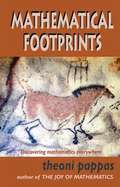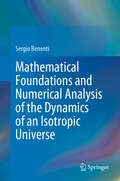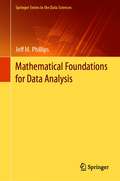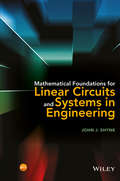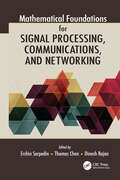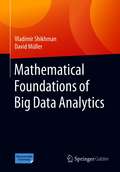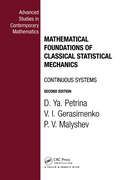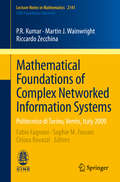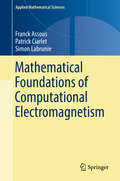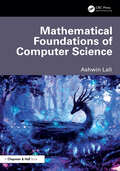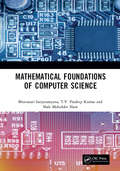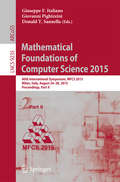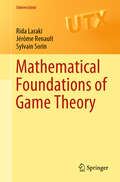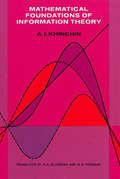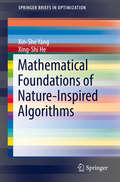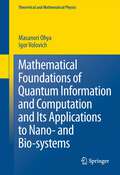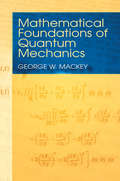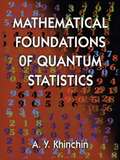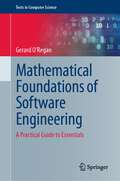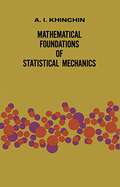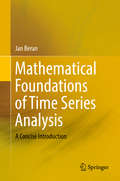- Table View
- List View
Mathematical Financial Economics
by Igor V. Evstigneev Thorsten Hens Klaus Reiner Schenk-HoppéThis textbook is an elementary introduction to the key topics in mathematical finance and financial economics - two realms of ideas that substantially overlap but are often treated separately from each other. Our goal is to present the highlights in the field, with the emphasis on the financial and economic content of the models, concepts and results. The book provides a novel, unified treatment of the subject by deriving each topic from common fundamental principles and showing the interrelations between the key themes. Although the presentation is fully rigorous, with some rare and clearly marked exceptions, the book restricts itself to the use of only elementary mathematical concepts and techniques. No advanced mathematics (such as stochastic calculus) is used.
Mathematical Footprints
by Theoni PappasMATHEMATICAL FOOTPRINTS takes a creative look at the role mathematics has played since prehistoric times, and will play in the future, and uncovers mathematics where you least expect to find it from its many uses in medicine, the sciences, and its appearance in art to its patterns in nature and its central role in the development of computers. Pappas presents mathematical ideas in a readable non-threatening manner.MATHEMATICAL FOOTPRINTS is another gem by the creator of THE MATHEMATICS CALENDAR and author of THE JOY OF MATHEMATICS."Pappas's books have been gold mines of mathematical entertainment...spreading inspirational and mathematical good cheer. " - Jon Scieszka, author of Math Curse
Mathematical Foundations and Applications of Graph Entropy
by Matthias Dehmer Frank Emmert-Streib Xueliang Li Yongtang Shi Zengqiang ChenThis latest addition to the successful Network Biology series presents current methods for determining the entropy of networks, making it the first to cover the recently established Quantitative Graph Theory. An excellent international team of editors and contributors provides an up-to-date outlook for the field, covering a broad range of graph entropy-related concepts and methods. The topics range from analyzing mathematical properties of methods right up to applying them in real-life areas. Filling a gap in the contemporary literature this is an invaluable reference for a number of disciplines, including mathematicians, computer scientists, computational biologists, and structural chemists.
Mathematical Foundations and Numerical Analysis of the Dynamics of an Isotropic Universe
by Sergio BenentiThis book is an enhanced and expanded English edition of the treatise “Fondamenti matematici e analisi numerica della dinamica di un Universo isotropo,” published by the Accademia delle Scienze di Torino in volume no. 42-43, 2018-2019. The book summarizes some of the principal findings from a long-term cosmology research project, aiming to clarify significant results through clear mathematical postulates. Despite efforts, a single mathematical model accurately describing the universe’s evolution remains elusive due to early universe complexity and numerous observational parameters. Over the past century, various models have been proposed and discarded, illustrated by debates on the cosmological constant and spatial curvature assumptions. Currently, many models lack clear foundations, causing confusion in the field. Standard cosmological approaches rely on principles like Weyl’s principle, homogeneity, and isotropy, but may overlook discerning purely geometrical properties from those dependent on field equations. This book aims to bring order to cosmology by starting from understandable mathematical postulates, leading to theorems. Disagreements on postulates can prompt adjustments or alternative approaches. Physics often consists of deductive theories lacking explicit delineation of underlying concepts and postulates, a criticism relevant to cosmological theories. Despite a late 1990s consensus on the Lambda cold dark matter model, the absence of a logical-deductive structure in literature complicates understanding, leading some to humorously dub it the “expanding Universe and expanding confusion.”
Mathematical Foundations for Data Analysis (Springer Series in the Data Sciences)
by Jeff M. PhillipsThis textbook, suitable for an early undergraduate up to a graduate course, provides an overview of many basic principles and techniques needed for modern data analysis. In particular, this book was designed and written as preparation for students planning to take rigorous Machine Learning and Data Mining courses. It introduces key conceptual tools necessary for data analysis, including concentration of measure and PAC bounds, cross validation, gradient descent, and principal component analysis. It also surveys basic techniques in supervised (regression and classification) and unsupervised learning (dimensionality reduction and clustering) through an accessible, simplified presentation. Students are recommended to have some background in calculus, probability, and linear algebra. Some familiarity with programming and algorithms is useful to understand advanced topics on computational techniques.
Mathematical Foundations for Linear Circuits and Systems in Engineering
by John J. ShynkExtensive coverage of mathematical techniques used in engineering with an emphasis on applications in linear circuits and systems Mathematical Foundations for Linear Circuits and Systems in Engineering provides an integrated approach to learning the necessary mathematics specifically used to describe and analyze linear circuits and systems. The chapters develop and examine several mathematical models consisting of one or more equations used in engineering to represent various physical systems. The techniques are discussed in-depth so that the reader has a better understanding of how and why these methods work. Specific topics covered include complex variables, linear equations and matrices, various types of signals, solutions of differential equations, convolution, filter designs, and the widely used Laplace and Fourier transforms. The book also presents a discussion of some mechanical systems that mathematically exhibit the same dynamic properties as electrical circuits. Extensive summaries of important functions and their transforms, set theory, series expansions, various identities, and the Lambert W-function are provided in the appendices. The book has the following features: Compares linear circuits and mechanical systems that are modeled by similar ordinary differential equations, in order to provide an intuitive understanding of different types of linear time-invariant systems. Introduces the theory of generalized functions, which are defined by their behavior under an integral, and describes several properties including derivatives and their Laplace and Fourier transforms. Contains numerous tables and figures that summarize useful mathematical expressions and example results for specific circuits and systems, which reinforce the material and illustrate subtle points. Provides access to a companion website that includes a solutions manual with MATLAB code for the end-of-chapter problems. Mathematical Foundations for Linear Circuits and Systems in Engineering is written for upper undergraduate and first-year graduate students in the fields of electrical and mechanical engineering. This book is also a reference for electrical, mechanical, and computer engineers as well as applied mathematicians. John J. Shynk, PhD, is Professor of Electrical and Computer Engineering at the University of California, Santa Barbara. He was a Member of Technical Staff at Bell Laboratories, and received degrees in systems engineering, electrical engineering, and statistics from Boston University and Stanford University.
Mathematical Foundations for Signal Processing, Communications, and Networking
by Erchin Serpedin, Thomas Chen and Dinesh RajanMathematical Foundations for Signal Processing, Communications, and Networking describes mathematical concepts and results important in the design, analysis, and optimization of signal processing algorithms, modern communication systems, and networks. Helping readers master key techniques and comprehend the current research literature, the book offers a comprehensive overview of methods and applications from linear algebra, numerical analysis, statistics, probability, stochastic processes, and optimization. From basic transforms to Monte Carlo simulation to linear programming, the text covers a broad range of mathematical techniques essential to understanding the concepts and results in signal processing, telecommunications, and networking. Along with discussing mathematical theory, each self-contained chapter presents examples that illustrate the use of various mathematical concepts to solve different applications. Each chapter also includes a set of homework exercises and readings for additional study. This text helps readers understand fundamental and advanced results as well as recent research trends in the interrelated fields of signal processing, telecommunications, and networking. It provides all the necessary mathematical background to prepare students for more advanced courses and train specialists working in these areas.
Mathematical Foundations of Big Data Analytics
by David Müller Vladimir ShikhmanIn this textbook, basic mathematical models used in Big Data Analytics are presented and application-oriented references to relevant practical issues are made. Necessary mathematical tools are examined and applied to current problems of data analysis, such as brand loyalty, portfolio selection, credit investigation, quality control, product clustering, asset pricing etc. – mainly in an economic context. In addition, we discuss interdisciplinary applications to biology, linguistics, sociology, electrical engineering, computer science and artificial intelligence. For the models, we make use of a wide range of mathematics – from basic disciplines of numerical linear algebra, statistics and optimization to more specialized game, graph and even complexity theories. By doing so, we cover all relevant techniques commonly used in Big Data Analytics.Each chapter starts with a concrete practical problem whose primary aim is to motivate the study of a particular Big Data Analytics technique. Next, mathematical results follow – including important definitions, auxiliary statements and conclusions arising. Case-studies help to deepen the acquired knowledge by applying it in an interdisciplinary context. Exercises serve to improve understanding of the underlying theory. Complete solutions for exercises can be consulted by the interested reader at the end of the textbook; for some which have to be solved numerically, we provide descriptions of algorithms in Python code as supplementary material.This textbook has been recommended and developed for university courses in Germany, Austria and Switzerland.
Mathematical Foundations of Classical Statistical Mechanics
by D.Ya. Petrina V.I. Gerasimenko P V MalyshevThis monograph considers systems of infinite number of particles, in particular the justification of the procedure of thermodynamic limit transition. The authors discuss the equilibrium and non-equilibrium states of infinite classical statistical systems. Those states are defined in terms of stationary and nonstationary solutions to the Bogolyubov
Mathematical Foundations of Complex Networked Information Systems
by Chiara Ravazzi P. R. Kumar Martin J. Wainwright Riccardo Zecchinafabio Fagnani Sophie M. FossonIntroducing the reader to the mathematics beyond complex networked systems, these lecture notes investigate graph theory, graphical models, and methods from statistical physics. Complex networked systems play a fundamental role in our society, both in everyday life and in scientific research, with applications ranging from physics and biology to economics and finance. The book is self-contained, and requires only an undergraduate mathematical background.
Mathematical Foundations of Computational Electromagnetism (Applied Mathematical Sciences #198)
by Franck Assous Patrick Ciarlet Simon LabrunieThis book presents an in-depth treatment of various mathematical aspects of electromagnetism and Maxwell's equations: from modeling issues to well-posedness results and the coupled models of plasma physics (Vlasov-Maxwell and Vlasov-Poisson systems) and magnetohydrodynamics (MHD). These equations and boundary conditions are discussed, including a brief review of absorbing boundary conditions. The focus then moves to well‐posedness results. The relevant function spaces are introduced, with an emphasis on boundary and topological conditions. General variational frameworks are defined for static and quasi-static problems, time-harmonic problems (including fixed frequency or Helmholtz-like problems and unknown frequency or eigenvalue problems), and time-dependent problems, with or without constraints. They are then applied to prove the well-posedness of Maxwell’s equations and their simplified models, in the various settings described above. The book is completed with a discussion of dimensionally reduced models in prismatic and axisymmetric geometries, and a survey of existence and uniqueness results for the Vlasov-Poisson, Vlasov-Maxwell and MHD equations. The book addresses mainly researchers in applied mathematics who work on Maxwell’s equations. However, it can be used for master or doctorate-level courses on mathematical electromagnetism as it requires only a bachelor-level knowledge of analysis.
Mathematical Foundations of Computer Science
by Ashwin LallMathematical Foundations of Computer Science introduces students to the discrete mathematics needed later in their Computer Science coursework with theory of computation topics interleaved throughout. Students learn about mathematical concepts just in time to apply them to theory of computation ideas. For instance, sets motivate the study of finite automata, direct proof is practised using closure properties, induction is used to prove the language of an automaton, and contradiction is used to apply the pumping lemma. The main content of the book starts with primitive data types such as sets and strings and ends with showing the undecidability of the halting problem. There are also appendix chapters on combinatorics, probability, elementary number theory, asymptotic notation, graphs, loop invariants, and recurrences. The content is laid out concisely with a heavy reliance on worked examples, of which there are over 250 in the book. Each chapter has exercises, totalling 550. This class-tested textbook is targeted to intermediate Computer Science majors, and it is primarily intended for a discrete math / proofs course in a Computer Science major. It is also suitable for introductory theory of computation courses.The authors hope this book breeds curiosity into the subject and is designed to satisfy this to some extent by reading this book. The book will prepare readers for deeper study of game theory applications in many fields of study.
Mathematical Foundations of Computer Science
by Bhavanari Satyanarayana T.V. Pradeep Kumar Shak Mohiddin ShawPlease note: Taylor & Francis does not sell or distribute the Hardback in India, Pakistan, Nepal, Bhutan, Bangladesh and Sri Lanka
Mathematical Foundations of Computer Science 2015
by Giuseppe F Italiano Giovanni Pighizzini Donald T. SannellaThis two volume set LNCS 9234 and 9235 constitutes the refereed conference proceedings of the 40th International Symposium on Mathematical Foundations of Computer Science, MFCS 2015, held in Milan, Italy, in August 2015. The 82 revised full papers presented together with 5 invited talks were carefully selected from 201 submissions. The papers feature high-quality research in all branches of theoretical computer science. They have been organized in the following topical main sections: logic, semantics, automata, and theory of programming (volume 1) and algorithms, complexity, and games (volume 2).
Mathematical Foundations of Game Theory (Universitext)
by Sylvain Sorin Rida Laraki Jérôme RenaultThis book gives a concise presentation of the mathematical foundations of Game Theory, with an emphasis on strategic analysis linked to information and dynamics. It is largely self-contained, with all of the key tools and concepts defined in the text.Combining the basics of Game Theory, such as value existence theorems in zero-sum games and equilibrium existence theorems for non-zero-sum games, with a selection of important and more recent topics such as the equilibrium manifold and learning dynamics, the book quickly takes the reader close to the state of the art. Applications to economics, biology, and learning are included, and the exercises, which often contain noteworthy results, provide an important complement to the text.Based on lectures given in Paris over several years, this textbook will be useful for rigorous, up-to-date courses on the subject. Apart from an interest in strategic thinking and a taste for mathematical formalism, the only prerequisite for reading the book is a solid knowledge of mathematics at the undergraduate level, including basic analysis, linear algebra, and probability.
Mathematical Foundations of Infinite-Dimensional Statistical Models
by Evarist Giné Richard NicklIn nonparametric and high-dimensional statistical models, the classical Gauss-Fisher-Le Cam theory of the optimality of maximum likelihood estimators and Bayesian posterior inference does not apply, and new foundations and ideas have been developed in the past several decades. This book gives a coherent account of the statistical theory in infinite-dimensional parameter spaces. The mathematical foundations include self-contained 'mini-courses' on the theory of Gaussian and empirical processes, on approximation and wavelet theory, and on the basic theory of function spaces. The theory of statistical inference in such models - hypothesis testing, estimation and confidence sets - is then presented within the minimax paradigm of decision theory. This includes the basic theory of convolution kernel and projection estimation, but also Bayesian nonparametrics and nonparametric maximum likelihood estimation. In the final chapter, the theory of adaptive inference in nonparametric models is developed, including Lepski's method, wavelet thresholding, and adaptive inference for self-similar functions.
Mathematical Foundations of Information Theory (Dover Books on Mathematics)
by A. Ya. KhinchinThe first comprehensive introduction to information theory, this book places the work begun by Shannon and continued by McMillan, Feinstein, and Khinchin on a rigorous mathematical basis. For the first time, mathematicians, statisticians, physicists, cyberneticists, and communications engineers are offered a lucid, comprehensive introduction to this rapidly growing field.In his first paper, Dr. Khinchin develops the concept of entropy in probability theory as a measure of uncertainty of a finite “scheme,” and discusses a simple application to coding theory. The second paper investigates the restrictions previously placed on the study of sources, channels, and codes and attempts “to give a complete, detailed proof of both … Shannon theorems, assuming any ergodic source and any stationary channel with a finite memory.”Partial Contents: I. The Entropy Concept in Probability Theory — Entropy of Finite Schemes. The Uniqueness Theorem. Entropy of Markov chains. Application to Coding Theory. II. On the Fundamental Theorems of Information Theory — Two generalizations of Shannon’s inequality. Three inequalities of Feinstein. Concept of a source. Stationarity. Entropy. Ergodic sources. The E property. The martingale concept. Noise. Anticipation and memory. Connection of the channel to the source. Feinstein’s Fundamental Lemma. Coding. The first Shannon theorem. The second Shannon theorem.
Mathematical Foundations of Nature-Inspired Algorithms (SpringerBriefs in Optimization)
by Xin-She Yang Xing-Shi HeThis book presents a systematic approach to analyze nature-inspired algorithms. Beginning with an introduction to optimization methods and algorithms, this book moves on to provide a unified framework of mathematical analysis for convergence and stability. Specific nature-inspired algorithms include: swarm intelligence, ant colony optimization, particle swarm optimization, bee-inspired algorithms, bat algorithm, firefly algorithm, and cuckoo search. Algorithms are analyzed from a wide spectrum of theories and frameworks to offer insight to the main characteristics of algorithms and understand how and why they work for solving optimization problems. In-depth mathematical analyses are carried out for different perspectives, including complexity theory, fixed point theory, dynamical systems, self-organization, Bayesian framework, Markov chain framework, filter theory, statistical learning, and statistical measures. Students and researchers in optimization, operations research, artificial intelligence, data mining, machine learning, computer science, and management sciences will see the pros and cons of a variety of algorithms through detailed examples and a comparison of algorithms.
Mathematical Foundations of Neuroscience
by David H. Terman G. Bard ErmentroutThis book applies methods from nonlinear dynamics to problems in neuroscience. It uses modern mathematical approaches to understand patterns of neuronal activity seen in experiments and models of neuronal behavior. The intended audience is researchers interested in applying mathematics to important problems in neuroscience, and neuroscientists who would like to understand how to create models, as well as the mathematical and computational methods for analyzing them. The authors take a very broad approach and use many different methods to solve and understand complex models of neurons and circuits. They explain and combine numerical, analytical, dynamical systems and perturbation methods to produce a modern approach to the types of model equations that arise in neuroscience. There are extensive chapters on the role of noise, multiple time scales and spatial interactions in generating complex activity patterns found in experiments. The early chapters require little more than basic calculus and some elementary differential equations and can form the core of a computational neuroscience course. Later chapters can be used as a basis for a graduate class and as a source for current research in mathematical neuroscience. The book contains a large number of illustrations, chapter summaries and hundreds of exercises which are motivated by issues that arise in biology, and involve both computation and analysis. Bard Ermentrout is Professor of Computational Biology and Professor of Mathematics at the University of Pittsburgh. David Terman is Professor of Mathematics at the Ohio State University. "This excellent 422 page hardcover publication is an accessible and concise monograph. ... Mathematical Foundations is a timely contribution that will prove useful to mathematics graduate students and faculty interested in the application of dynamical systems theory to cellular and systems neuroscience. ... welcome addition to the pedagogical literature. ... For mathematics graduate students who are investigating the field of computational neuroscience, I would highly recommend Mathematical Foundations of Neuroscience as their first computational neuroscience text." (Gregory D. Smith, The Mathematical Association of America, December, 2010) "...it is a good substitute for a lengthy regime of abstract maths classes, but it is also well integrated into the field of neuroscience. Ermentrout and Terman's book conveys much of the advanced mathematics used in theoretical neuroscience today." (Vincent A. Billock, Nature)
Mathematical Foundations of Quantum Information and Computation and Its Applications to Nano- and Bio-systems
by Masanori Ohya I. VolovichThis monograph provides a mathematical foundation to the theory of quantum information and computation, with applications to various open systems including nano and bio systems. It includes introductory material on algorithm, functional analysis, probability theory, information theory, quantum mechanics and quantum field theory. Apart from standard material on quantum information like quantum algorithm and teleportation, the authors discuss findings on the theory of entropy in C*-dynamical systems, space-time dependence of quantum entangled states, entangling operators, adaptive dynamics, relativistic quantum information, and a new paradigm for quantum computation beyond the usual quantum Turing machine. Also, some important applications of information theory to genetics and life sciences, as well as recent experimental and theoretical discoveries in quantum photosynthesis are described.
Mathematical Foundations of Quantum Mechanics (Dover Books On Physics Series)
by George W. MackeyDesigned for students familiar with abstract mathematical concepts but possessing little knowledge of physics, this text focuses on generality and careful formulation rather than problem-solving. Its author, a member of the distinguished National Academy of Science, based this graduate-level text on the course he taught at Harvard University.Opening chapters on classical mechanics examine the laws of particle mechanics; generalized coordinates and differentiable manifolds; oscillations, waves, and Hilbert space; and statistical mechanics. A survey of quantum mechanics covers the old quantum theory; the quantum-mechanical substitute for phase space; quantum dynamics and the Schrödinger equation; the canonical "quantization" of a classical system; some elementary examples and original discoveries by Schrödinger and Heisenberg; generalized coordinates; linear systems and the quantization of the electromagnetic field; and quantum-statistical mechanics.The final section on group theory and quantum mechanics of the atom explores basic notions in the theory of group representations; perturbations and the group theoretical classification of eigenvalues; spherical symmetry and spin; and the n-electron atom and the Pauli exclusion principle.
Mathematical Foundations of Quantum Statistics (Dover Books on Mathematics)
by A. Y. KhinchinA coherent, well-organized look at the basis of quantum statistics’ computational methods, the determination of the mean values of occupation numbers, the foundations of the statistics of photons and material particles, thermodynamics.
Mathematical Foundations of Software Engineering: A Practical Guide to Essentials (Texts in Computer Science)
by Gerard O'ReganThis textbook presents an introduction to the mathematical foundations of software engineering. It presents the rich applications of mathematics in areas such as error-correcting codes, cryptography, the safety and security critical fields, the banking and insurance fields, as well as traditional engineering applications. Topics and features: Addresses core mathematics for critical thinking and problem solving Discusses propositional and predicate logic and various proof techniques to demonstrate the correctness of a logical argument. Examines number theory and its applications to cryptography Considers the underlying mathematics of error-correcting codes Discusses graph theory and its applications to modelling networks Reviews tools to support software engineering mathematics, including automated and interactive theorem provers and model checking Discusses financial software engineering, including simple and compound interest, probability and statistics, and operations research Discusses software reliability and dependability and explains formal methods used to derive a program from its specification Discusses calculus, matrices, vectors, complex numbers, and quaternions, as well as applications to graphics and robotics Includes key learning topics, summaries, and review questions in each chapter, together with a useful glossary This practical and easy-to-follow textbook/reference is ideal for computer science students seeking to learn how mathematics can assist them in building high-quality and reliable software on time and on budget. The text also serves as an excellent self-study primer for software engineers, quality professionals, and software managers.
Mathematical Foundations of Statistical Mechanics (Dover Books on Mathematics)
by A. Ya. KhinchinPhase space, ergodic problems, central limit theorem, dispersion and distribution of sum functions. Chapters include Geometry and Kinematics of the Phase Space; Reduction to the Problem of the Theory of Probability; and more.
Mathematical Foundations of Time Series Analysis: A Concise Introduction
by Jan BeranThis book provides a concise introduction to the mathematical foundations of time series analysis, with an emphasis on mathematical clarity. The text is reduced to the essential logical core, mostly using the symbolic language of mathematics, thus enabling readers to very quickly grasp the essential reasoning behind time series analysis. It appeals to anybody wanting to understand time series in a precise, mathematical manner. It is suitable for graduate courses in time series analysis but is equally useful as a reference work for students and researchers alike.

